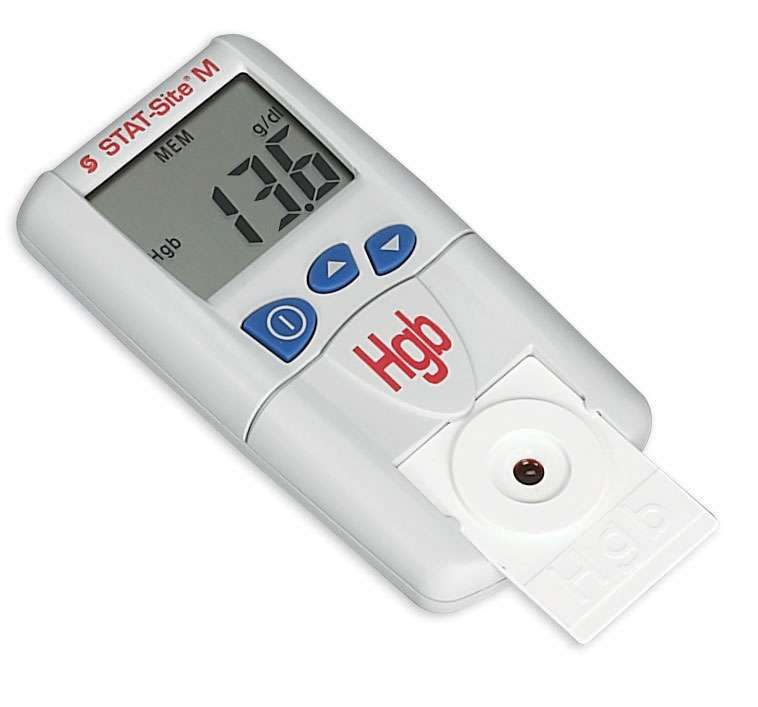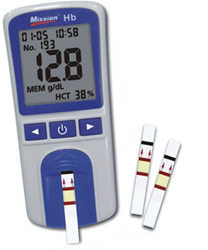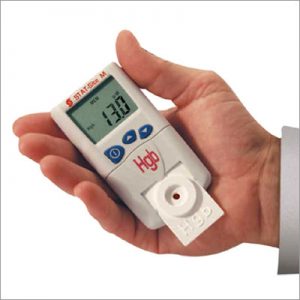Categories
Hemoglobin meter

The existence of glucometer (to check blood sugar level) or sphygmomanometer (to check blood pressure level) is acknowledged by most of us; however, we fail to recognize the existence of Hemoglobin meter. Hemoglobin meter is equally important as a glucometer or a sphygmomanometer. Hemoglobin meter helps to measure the level of hemoglobin in our body and also further calculates the value of hematocrit.
Hemoglobin is an important protein molecule that is located within our red blood cells. It is the receptor for oxygen binding to the red blood cell and also for the transport of oxygen to different parts of our body. In addition, hemoglobin also transports carbon dioxide away from the tissue and aids in the excretion of the carbon dioxide gas. But, why do we need to measure the hemoglobin level? Hemoglobin is one of the determinant factors in iron deficiency anemia, where the level of the hemoglobin and the hematocrit determines the severity of the disease. The Hemoglobin meter comes in handy at home to get the reading and to notify the doctor, in order to begin the treatment procedure right away without any delay. The delay of the treatment could cause serious complications.
Hemoglobin meter comes as a portable device that resembles a glucometer and the procedure to check the hemoglobin level with the help of a hemoglobin meter is primitive. But, in order to learn more about the procedure, we need to be familiar with the parts of the hemoglobin meter.
Contents
Features of Hemoglobin Meter
Hemoglobin meter consists of many parts, but the major parts of the hemoglobin meter can be listed as below.
Hemoglobin meter
The hemoglobin meter read the data from the inserted strip with blood. After analyzing the content of the blood, the hemoglobin level and hematocrit is calculated.

Code chip
The code chip of the hemoglobin meter helps to calibrate the meter with a code number.
Capillary blood transfer dropper
The capillary blood transfer dropper collects the sample of blood needed by the test strip to examine its content by hemoglobin meter. This is usually measured as 10µl of blood. There is usually 10 capillary blood transfer dropper comes with hemoglobin meter.
Canister of test strips
There is only one canister of test strips comes with hemoglobin meter and these strips are used to connect the blood with the hemoglobin meter. Moreover, there are two other test strips comes with every hemoglobin meter to check the accuracy of the hemoglobin meter and to calibrate it.
Pen like lancing device with sterile lancets
Lancing device helps to prick the fingertip with the help of a sterile lancet for every time usage. In addition, the lancing device can be calibrated for different depth in order to prick the fingertip and this can be done easily by turning the front part of the lancing device. The sterile lancet is disposed of after one-time usage.
Screen of the hemoglobin meter
The LCD screen of the hemoglobin meter displays the values of the hemoglobin level and of the hematocrit.
How does the hemoglobin meter functions?
In order to perform the procedure to measure the hemoglobin level, the proper handling of the hemoglobin meter, test strip and the capillary blood transfer dropper are needed. The hemoglobin meter should be turned on and the date and time should be set. After that, the code chip comes with each canister should be inserted through its exclusive port in the hemoglobin meter, in order to give code number for each measurement.
Later, the lancing device should be inserted with a new, sterile lancet. In addition, test strip should be taken from the canister and should be made ready for insertion into the hemoglobin meter.
Before inserting the test strip, you need to make sure that the blood sample is placed correctly on the sample holder of the test strip. In order to get an accurate reading, the fingertip should be wiped with clean cotton (but avoid alcohol wipes). After that, the front part of the lancing device should be rotated to produce the necessary depth of the prick. Collect the blood sample carefully with the help of capillary blood transfer dropper.
Alternatively, venous blood samples also can be used instead of fingertip blood testing. The venous sample blood should be taken with heparin anticoagulants. Moreover, the blood should be shaken thoroughly before taking the sample with the help of capillary blood transfer dropper.

For more accurate results, the blood sample should be at least 10µl. As soon as the test strip is inserted correctly, the LCD screen of hemoglobin meter shows the icon of the test strip. This shows that the test strip is correctly inserted. After the insertion of the test strip, add the sample of blood to the sampling area of the test strip. After a few seconds, the measurement of the hemoglobin level is shown on the screen along with the reading of hematocrit.
The reading of the hemoglobin measurement is stored with a unique code number, time and date for later. Moreover, the usual range of hemoglobin level that can be detected by hemoglobin meter is 5-25.6 g/dL.
Hemoglobin meter is able to detect the concentration of hemoglobin through the reaction of reagents in the test strip with the blood. The reagents in the test strip are sodium deoxycholate and sodium nitrite.
Interpretation of the results
The hemoglobin amount that is present within the red blood cells are removed and its contents measured. The usual range of normal values of the result according to gender and age are given below.
- For men, the normal range of hemoglobin concentration is between 13.0-17.0 g/dL.
- For women, the normal range of hemoglobin is 12.0-15.0 g/dL
- For Children, the normal range of hemoglobin is 11.0 -14.0 g/dL
These results are the usual norms, but it may change according to the laboratories and the location in which the result is interpreted.
Maintenance of the hemoglobin meter
The hemoglobin meter should be maintained properly to produce accurate results. The maintenance of the hemoglobin has two important parts:
Cleaning
The hemoglobin meter should be cleaned every day and after every use in order to produce accurate results. The surface of the hemoglobin meter should be cleaned with the help of a cotton cloth. However, you may use damp cotton cloth also can be used to clean the surface of the hemoglobin meter.
Moreover, a dry and a soft cloth should be used to clean the LCD screen and the sensor area. The harsh clothes or damp cloth can cause damage to the screen as well as to the sensor area. Also, utmost care should be provided in order to avoid any liquid or any other foreign materials enter the strip channel, exclusive port for code chip and USB port. The failure to do this might permanently damage the hemoglobin meter. And also, after cleaning the meter, the meter should be stored in its carrying case. This avoids further exposure to the harsh environmental conditions.
Another important part of the hemoglobin meter which needs to be cleaned is test strip holder, as this can prevent any contamination of the sample. The test strip holder can be removed from the meter by pressing on the middle of the holder and slide it from its location. This holder should be cleaned with mild detergent and should be dried thoroughly after cleaning it. After the test strip holder dries, replace it to the same location by firmly pressing the holder’s center downward with the help of the thumb. You can make sure that the test strip holder is in place by hearing the click sound when pressing the holder. The click sound ensures that the test strip holder is in its place.
Another important location that needs to be cleaned is meter sensor area. After removing the test strip holder, the exposed area is the meter sensor area. This area of the hemoglobin meter is extremely delicate and more prone to damage. Therefore, a cotton swab should be used to carefully cleaning this area. Do not try to scratch the sensor, but gently wipe it with the help of a cotton swab.
Replacing the Batteries
If the battery icon is flashing, it means that the battery of the hemoglobin meter is running low and should be replaced as soon as possible. An error message will appear on the screen of the hemoglobin meter if the battery is too low to perform any more tests. The meter will not resume its function until the battery is replaced.
In order to replace the battery, make sure the hemoglobin meter is off before removing the battery. Turn the meter over to find the battery cover. Press the battery cover tab on the top of it and lift the cover to open it expose the old battery. Remove and discard the old batteries.
Replace the old battery with three AAA batteries on top of the plastic tape. Make sure that the two outside batteries are aligned with the plus side down, towards the bottom of the meter, with the middle battery aligned with the plus side up, towards the top of the meter. If the batteries are arranged in a different direction than mentioned above, the hemoglobin meter would not function. Therefore, care should be taken while replacing the batteries.
After replacing the battery, close the battery cover and make sure that the battery cover is properly closed. Recheck and reset the clock setting as necessary after battery replacement to ensure time is set correctly in order to maintain the accuracy of the results.
Precautions
There are certain precautions should be followed in order to produce accurate results and also for the proper functioning of the hemoglobin meter. It is highly important to read the user manual in order to familiarize with the features and the procedures. The improper handling of this instrument results in the malfunctioning of the apparatus.
In addition, gloves should be worn while dealing with biological specimens. It is always safe to avoid direct contact with the biological specimen. The gloves should be disposed of after each use.
The hemoglobin meter should be kept away from direct exposure to harsh weather conditions (high temperature, low temperature or high humidity) as this can interfere with the sensor and reduces the efficiency and accuracy of hemoglobin meter.
The cleaning of the meter and its other parts should only be done with the help of water. The uses of alcohol, gasoline, organic solvents, paint thinner or perfume should be completely avoided. The usage of these liquids can cause severe damage to the hemoglobin meter. However, the use of water also should be avoided while cleaning the LCD screen of the meter.
The test strip also subjected to severe damage due to the exposure of these strips to temperature conditions beyond its acceptable value. The meter can work with its full efficiency in the temperature range of 10-40C and of humidity less than 90%, while the test strip should be maintained at a temperature range of 15-30C and the humidity less than 85%. Moreover, the test strips should be stored in dry and cool place. However, avoid freezing or refrigerating the test strips. The transport of these test strips should be in the form of a closed canister and the temperature conditions should be maintained. The optimal temperature range for the transport is 2-30C and the humidity should be less than 85%.
In addition, the expired test strips should be disposed of and the usage of expired test strips produces an incorrect reading on the meter. Therefore, care should be taken while using the test strip and the date of expiration should be checked before each usage.
Even though people know only a little about this smart device, according to World Health Organization (WHO), a hemoglobin meter can be a very important part of diagnosing, preventing and treating anemia. According to statistics many children in the world suffer from iron deficiency anemia during the most critical phases of their growth. Therefore, parents, who have growing kids, should consider having a hemoglobin meter at home, just to make sure that their body’s iron balance is well maintained.



